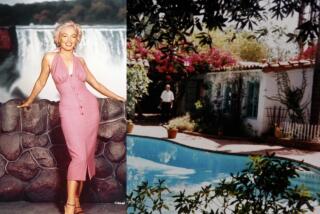Preserving a House for People and President
- Share via
It has been sprayed with bullets, splashed with blood, hit by a plane and--just last week--defaced with paint.
The most recent attack on the White House came in the Blue Room on Jan. 14. A woman taking a public tour sprayed rust-colored paint on the marble busts of Christopher Columbus and Amerigo Vespucci.
The White House has taken its share of hits over the years. Still, the greater wear and tear comes from the steady stream of visitors and guests.
“You know, it’s the people’s house,” says Janice Johnson of Laguna Beach, a member for four years of the Committee for the Preservation of the White House.
“It’s the only home of a head of state that’s open to the public. The first family gives up a lot of privacy to let the public in.”
Johnson goes to Washington this week for a meeting with First Lady Hillary Rodham Clinton about the preservation group’s latest project: the refurbishment of the State Dining Room.
“It’s in bad need,” Johnson says of the room where heads of state dine as they chat about world affairs. It was last touched up in 1982. “One man on the committee says it looks like ‘early country club.’ ”
Since her return to Orange County more than a year ago from Washington--where her husband, Roger Johnson, served as chief of the General Services Administration--Johnson has made regular visits to the White House. She has attended meetings and special receptions--even spent the night in the Lincoln Bedroom on her wedding anniversary.
“Every time I go to the White House, it’s such a thrill,” Johnson says. “There’s so much history there, so much art, so much to learn. It’s a tremendous privilege.”
Tuesday’s White House meeting will take place in the golden-hued State Dining Room at a mahogany table surrounded by Queen Anne-style chairs.
On the agenda: decisions about wall color, carpet and upholstery fabric, lighting fixtures, table finishes and whether the room can accommodate an original 1902 White House mantel now housed in the Truman Library.
There’s a great story about that mantel, Johnson says. “During the Truman Administration, they gutted the White House and stored all of the moldings, mantels and fireplaces.
“When they went to put the State Dining Room back together, they couldn’t find the mantel. Somehow, it ended up many years later in the Truman Library.
“And when the White House curator asked for it back, Truman said no way!”
A copy of the mantel was made for the State Dining Room, but it was smaller than the original. “Now, the Truman Library has offered to return the original, but only if we use it in the dining room,” Johnson says. “So, we’re going to try to use it.”
The preservation committee, which counts East Coast designer Mark Hampton and White House curator Betty Monkman among its members, doesn’t always agree when it develops a decorating concept for the historic rooms, Johnson notes.
A recent example: “One faction of the committee wanted to take the State Dining Room back to the way it was during Teddy Roosevelt’s time, when it had heavy mahogany paneling and big-game trophies on the walls,” she says. Later, the trophies--a large moose head among them--were sent to the Smithsonian Institution.
Because the dark paneling has been painted repeatedly over the years, it would be a huge undertaking to return it to its original state.
“It would have looked so very, very dark,” Johnson says. “Many of us also felt that it wouldn’t be appropriate, going from the Red Room to the Green Room to the Blue Room with all of their wonderful off-white moldings into this big, dark, massive dining room.”
The winning point of view: “We’ll do the paneling in a kind of bisque shade with the moldings done in gradations of off-white,” she says.
On Wednesday, Johnson will dine with the first lady and the president in the State Dining Room to celebrate a $25-million endowment raised to preserve the public rooms of the White House.
Anyone wanting to become active in supporting the White House would do well to consider a contribution to the endowment fund, Johnson says.
“About 1.5 million people a year visit the White House. And our taxes do not pay for its upkeep.”
More to Read
Sign up for The Wild
We’ll help you find the best places to hike, bike and run, as well as the perfect silent spots for meditation and yoga.
You may occasionally receive promotional content from the Los Angeles Times.






